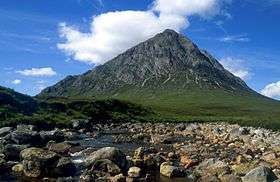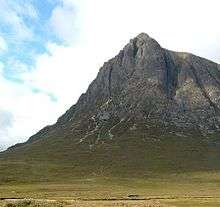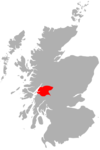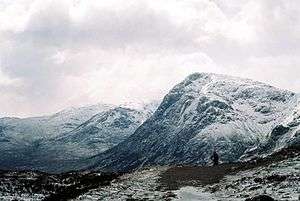Buachaille Etive Mòr
| Buachaille Etive Mòr | |
|---|---|
| Stob Dearg | |
 Stob Dearg from Glen Etive | |
| Highest point | |
| Elevation | 1,021 m (3,350 ft) [1] |
| Prominence | 533 m (1,749 ft) |
| Parent peak | Bidean nam Bian |
| Listing | Munro, Marilyn |
| Coordinates | 56°38′50.29″N 4°53′52.07″W / 56.6473028°N 4.8977972°WCoordinates: 56°38′50.29″N 4°53′52.07″W / 56.6473028°N 4.8977972°W |
| Naming | |
| Translation | Great Herdsman of Etive[2] (Gaelic) |
| Pronunciation |
Scottish Gaelic: [ˈpuəxəʎə ˈeʰtʲə moːɾ], /ˈbuːəxeɪl ˈɛtɪv ˈmɔːr/ |
| Geography | |
 Buachaille Etive Mòr Buachaille Etive Mòr | |
| Location | Glen Etive, Scotland |
| OS grid | NN223543 |
| Topo map | OS Landranger 41 |
| Listed summits of Buachaille Etive Mòr | ||||
| Name | Grid ref | Height | Status | |
|---|---|---|---|---|
| Stob Dearg | NN223543 | 1022 m (3352 ft) | Munro, Marilyn | |
| Stob na Doire | NN207532 | 1011 m (3317 ft) | Munro top | |
| Stob na Bròige | NN190525 | 956 m (3136 ft) | Munro | |
| Stob Coire Altruim | NN197530 | 941 m (3087 ft) | Munro top | |
Buachaille Etive Mòr (Scottish Gaelic: Buachaille Eite Mòr, meaning "the herdsman of Etive"), generally known to climbers simply as The Buachaille, is a mountain at the head of Glen Etive in the Highlands of Scotland. Its pyramidal form, as seen from the A82 road when travelling towards Glen Coe, makes it one of the most recognisable mountains in Scotland, and one of the most depicted on postcards and calendars.
Buachaille Etive Mòr takes the form of a ridge nearly five miles (8 km) in length, almost entirely encircled by the River Etive and its tributaries. The ridge contains four principal tops: from north-east to south-west these are Stob Dearg (1022 m), Stob na Doire (1011 m), Stob Coire Altruim (941 m) and Stob na Bròige (956 m). Stob Dearg and Stob na Bròige are both Munros; the latter was promoted to Munro status by the Scottish Mountaineering Club in 1997.[3]
Ascent
The steep, craggy north-eastern face of Stob Dearg forms the classic aspect of the mountain as seen from the Kings House Hotel, and constitutes the most direct route of ascent for climbers and scramblers. Crowberry Ridge, a classic rock climb graded severe, was first climbed direct – and photographed – in 1900 by the Abraham brothers with Messrs Puttrell and Baker. Immediately to the left is Curved Ridge, one of the most famous scrambling routes.
Alternatively there is a somewhat eroded path leading steeply up the Coire na Tulaich which, in summer conditions, allows walkers to ascend the peaks, reaching the ridge about half a kilometre west of Stob Dearg.
Buachaille Etive Mòr is separated from its sister mountain of Buachaille Etive Beag to the west by the valley of Lairig Gartain. To the east lies Glen Etive, which provides an alternative route of ascent, heading up steep grassy slopes to the summit of Stob na Bròige. Another route follows the Allt Coire Altruim from the Lairig Gartain, reaching the ridge about two thirds of the way along from the north. This route is often used as descent route in conjunction with an ascent via Coire na Tulaich, forming a circular route with a walk out along the Lairig Gartain.
On 24 January 2009, three mountain climbers were killed and one was seriously injured in an avalanche disaster.
In popular culture
Buachaille Etive Mòr appears in the background during a song sequence in the 1998 Bollywood film Kuch Kuch Hota Hai.[4][5] Together with Beinn a'Chrulaiste it can also be seen in the film Skyfall, where James Bond transports M away from the villain Raoul Silva.
See also
References
- ↑ "Scotland's Landscape Stob Dearg (Highland)". BBC Scotland. 2013. Retrieved 7 October 2013.
- ↑ Peter Hodgkiss, The Central Highlands, Scottish Mountaineering Club District Guidebook, 5th ed. (Scottish Mountaineering Trust, 1994)
- ↑ "Buachaille Etive Mor". walkhighlands.co.uk. Retrieved 23 December 2013.
- ↑ "Wealth of fans to locate". The Scotsman. 28 September 2002. Retrieved 27 December 2015.
- ↑ "Ticket tout fears over Bollywood star". The Scotsman. 8 August 2002. Retrieved 27 December 2015.
External links

- Database of British and Irish Hills. Accessed 8 November 2006.
- Mountain Pictures, pictures of Buachaille etive mor Picture gallery of Buachaille Etive Mor
| Wikimedia Commons has media related to Buachaille Etive Mòr. |

